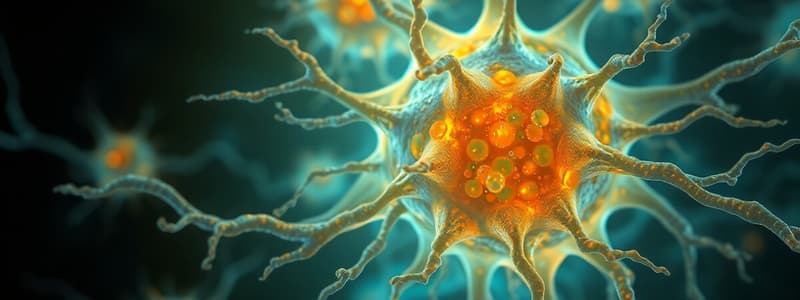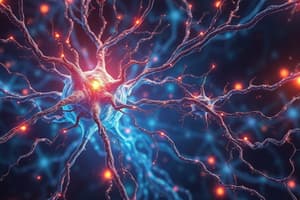Podcast
Questions and Answers
What function do oligodendrocytes perform in the central nervous system?
What function do oligodendrocytes perform in the central nervous system?
- Phagocytize debris in the CNS
- Wrap around nerve fibers to produce myelin sheaths (correct)
- Line the cavities of the brain and spinal cord
- Monitor the health of nearby neurons
Which type of glial cell is primarily involved in the immune defense of the CNS?
Which type of glial cell is primarily involved in the immune defense of the CNS?
- Astrocyte
- Microglial cell (correct)
- Ependymal cell
- Oligodendrocyte
What role do ependymal cells play in relation to cerebrospinal fluid?
What role do ependymal cells play in relation to cerebrospinal fluid?
- Monitoring neuron health
- Producing myelin sheaths
- Phagocytizing debris
- Assisting with circulation of cerebrospinal fluid (correct)
How are astrocytes characterized among glial cells?
How are astrocytes characterized among glial cells?
Which cell type is engaged in disposing of debris within the CNS?
Which cell type is engaged in disposing of debris within the CNS?
In what specific action do the processes of oligodendrocytes engage?
In what specific action do the processes of oligodendrocytes engage?
What is the primary function of astrocytes?
What is the primary function of astrocytes?
Which glial cell specifically has a spiderlike shape and function?
Which glial cell specifically has a spiderlike shape and function?
What is the role of calcium in neurotransmission at synapses?
What is the role of calcium in neurotransmission at synapses?
What happens after calcium enters the axon terminal during neurotransmission?
What happens after calcium enters the axon terminal during neurotransmission?
Which event follows the release of neurotransmitters into the synaptic cleft?
Which event follows the release of neurotransmitters into the synaptic cleft?
In the process of neurotransmission, what initiates the binding of neurotransmitter to the next neuron's membrane?
In the process of neurotransmission, what initiates the binding of neurotransmitter to the next neuron's membrane?
What occurs at the axon terminal when the neurotransmitter is released?
What occurs at the axon terminal when the neurotransmitter is released?
Which component is responsible for forming porelike openings during neurotransmission?
Which component is responsible for forming porelike openings during neurotransmission?
What is the final step in the transmission of the signal at chemical synapses?
What is the final step in the transmission of the signal at chemical synapses?
Which sequence correctly represents the events occurring at a synapse during neurotransmission?
Which sequence correctly represents the events occurring at a synapse during neurotransmission?
Which of the following is the correct order of elements in a basic reflex arc?
Which of the following is the correct order of elements in a basic reflex arc?
What is the role of the integration center in a reflex arc?
What is the role of the integration center in a reflex arc?
Which element of the reflex arc is responsible for carrying signals from the integration center to the effector?
Which element of the reflex arc is responsible for carrying signals from the integration center to the effector?
What is the primary function of the pons in the brain stem?
What is the primary function of the pons in the brain stem?
In a two-neuron reflex arc, what is another name for the sensory neuron?
In a two-neuron reflex arc, what is another name for the sensory neuron?
Which structure in the brain stem is most involved in controlling heart rate and blood pressure?
Which structure in the brain stem is most involved in controlling heart rate and blood pressure?
Which type of reflex arc is the simplest?
Which type of reflex arc is the simplest?
What is the function of the effector in a reflex arc?
What is the function of the effector in a reflex arc?
What role does the reticular formation play in the brain?
What role does the reticular formation play in the brain?
What is the structure that merges into the spinal cord?
What is the structure that merges into the spinal cord?
What is an example of a two-neuron reflex arc?
What is an example of a two-neuron reflex arc?
Which component of the reflex arc is primarily located in the spinal cord and facilitates communication between sensory and motor neurons?
Which component of the reflex arc is primarily located in the spinal cord and facilitates communication between sensory and motor neurons?
Which part of the brain is primarily responsible for the coordination of body movements?
Which part of the brain is primarily responsible for the coordination of body movements?
Which of the following structures is involved in motor control of visceral organs?
Which of the following structures is involved in motor control of visceral organs?
The outer cortex of the cerebrum is primarily composed of what type of tissue?
The outer cortex of the cerebrum is primarily composed of what type of tissue?
What system is associated with awake/sleep cycles and consciousness?
What system is associated with awake/sleep cycles and consciousness?
What is the first element in a two-neuron reflex arc?
What is the first element in a two-neuron reflex arc?
Which component is responsible for transmitting signals from the reflex action to the effector organ?
Which component is responsible for transmitting signals from the reflex action to the effector organ?
In a three-neuron reflex arc, which component is added between the sensory and motor neurons?
In a three-neuron reflex arc, which component is added between the sensory and motor neurons?
What is the role of the sensory (afferent) neuron in a reflex arc?
What is the role of the sensory (afferent) neuron in a reflex arc?
Which of the following describes the effector organ's function in a reflex arc?
Which of the following describes the effector organ's function in a reflex arc?
What is the primary difference between a two-neuron and a three-neuron reflex arc?
What is the primary difference between a two-neuron and a three-neuron reflex arc?
Which element is NOT part of a two-neuron reflex arc?
Which element is NOT part of a two-neuron reflex arc?
What type of reflex is an example of a three-neuron reflex arc?
What type of reflex is an example of a three-neuron reflex arc?
Flashcards are hidden until you start studying
Study Notes
Neuroglia Types and Functions
- Astrocytes: Most abundant and versatile glial cells, provide structural support and modulate neuronal activity.
- Microglial Cells: Spiderlike phagocytes that monitor neuronal health and clear debris, serving as the brain's immune defense.
- Ependymal Cells: Line brain and spinal cord cavities, cilia help circulate cerebrospinal fluid, aiding in nutrient distribution.
- Oligodendrocytes: Wrap around CNS nerve fibers, responsible for producing myelin sheaths which insulate axons for faster impulse transmission.
Neuron Communication at Synapses
- Calcium's Role: Entry of calcium into the axon terminal triggers vesicles containing neurotransmitters to fuse with the axonal membrane.
- Neurotransmitter Release: Vesicles release neurotransmitters into the synaptic cleft, facilitating communication between neurons.
- Receptor Binding: Neurotransmitter molecules diffuse across the synaptic cleft and bind to receptors on the postsynaptic neuron, initiating a response.
Reflex Arcs
- Basic Elements: Comprise receptor, sensory neuron, integration center (interneuron), motor neuron, and effector.
- Two-neuron Reflex Arc: Simplest form exemplified by the patellar (knee-jerk) reflex, involving only one sensory neuron and one motor neuron.
- Three-neuron Reflex Arc: Involves an additional interneuron, common in more complex reflex actions such as the flexor (withdrawal) reflex.
Brain Stem Structures
- Pons: Rounded structure below the midbrain, primarily fiber tracts, participates in respiratory control.
- Medulla Oblongata: Inferior part of the brain stem merging with the spinal cord, contains centers regulating heart rate, blood pressure, breathing, swallowing, and vomiting.
- Reticular Formation: A diffuse group of gray matter that controls visceral motor functions, plays a crucial role in sleep-wake cycles and sensory filtering.
Cerebrum Overview
- Hemispheres: Composed of two hemispheres with convoluted surfaces; the outer cortex consists of gray matter, while the inner region contains white matter.
- Functions: Coordinates balance, timing for skeletal muscle activity, and overall body movement coordination.
Studying That Suits You
Use AI to generate personalized quizzes and flashcards to suit your learning preferences.




